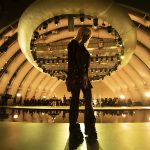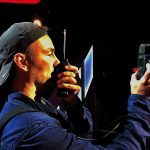
LED tape has been a staple on live events for quite some time. It’s mostly known for its use as eye candy that adds dimension to set pieces and its ability to be mapped to video. But when it comes to using the product as an actual light source — to illuminate something — most folks never think of that application. Unless you’re a gaffer, that is. In this article, PLSN presents some unique ways that LED tape was used for camera lighting applications.
In the two scenarios below, Rosco products were chosen by cinematographers to light talent. One thing to note is that they’re using slightly different products. Christopher Lew used the RoscoLED Tape Daylight Gaffer Kit, which has a fixed 5600K color temperature, in the first scenario. In the second scenario, Jay P. Morgan and The Slanted Lens team used the brand new RoscoLED Tape VariWhite Gaffer Kit, which features bi-color LEDs, to dial-in the color temperature needed on their shot.
›› Scenario 1: Shooting Inside a Mini Cooper
Christopher Lew is a cinematographer based in Toronto Ontario. His work covers commercials, music videos short films and branded content, with a focus on evocative imagery. Lew shot a spec ad for Mini Cooper last year. The ad called for an overnight, all exterior location shoot of different colored Mini Coopers driving through city streets in Toronto. Because it was shot at night, and the Mini Cooper is an ultra-compact car — Chris needed an ultra-compact lighting kit. The RoscoLED Tape Gaffer Kit was his solution. Below, Chris explains how he put the kit to work in the ad.

“The main challenges of this shoot were space and time. Obviously shooting inside and around a compact car like the mini was going to be a big challenge — especially considering the entire spot took place at night. Rosco’s LED tape saved me in two ways — its high output and ease of use. The connectivity between the LED strips and the accessories was plain and simple, which made the Gaffer Kit easy-to-use. This allowed me to hand the kit to a PA who had never used the lights before to get the car rigged up in no time, which freed me up to spend more time planning the shots with the director,” Lew says.
“On the shoot, we had two different Minis that were our picture cars. This often meant rigging one car, then tearing down and rigging the other as fast as possible. Thanks to the lightweight, small profile of the easy-to-use RoscoLED Tape, we were able to use regular old black paper tape to install the LEDs into position, which allowed us to get the strips in and out of the vehicles quickly.
“This particular tape is available in both tungsten and daylight versions,” Lew continues. “We decided on the 5600K daylight for two reasons: One, they matched most of the locations we were shooting in, that tended to have cooler/neutral white streets lights, and two, we also knew we wanted to go for a bluer night look in the grade.
“The output of the strips gave me peace of mind that, no matter what part of the city we were shooting in, I always had enough light to get a good exposure inside the car,” Lew concludes. “A diverse cast of different skin tones was no problem for the RoscoLED Tape. In fact, we never needed to bring any of the LED tape strips to 100 percent. Everything rigged inside the car was almost always dimmed down below 50 percent using the Single Fader Dimmer that came with the kit.”

›› Scenario 2: Lighting a Face Inside a Space Helmet
Jay P. Morgan posted a lesson on The Slanted Lens about how to light in small spaces. To illustrate this common issue, he used RoscoLED Tape VariWhite Gaffer Kit to illuminate the inside of an astronaut’s helmet on a recent space-themed shoot.
The RoscoLED Tape VariWhite Gaffer Kit features an assortment of bi-color, 12V RoscoLED Tape Strips and Tiles that enable image capture professionals to dial in the color temperature they need for their shot. Using the double-stick tape found on the RoscoLED Tape, Jay P. mounted the two 12-inch (30cm) strips from the kit inside the helmet so that he could establish a key light on his model’s face.
The VariWhite Gaffer Kit comes with two dimmers — a hardwired, 2-channel dimmer with faders and a wireless 2-channel RF remote. Both let users control the individual output of the cool and warm LEDs on the VariWhite Strips and Tiles to establish the color temperature and brightness level of the light. Jay P. mounted the strips along the upper and lower line of the helmet and controlled them separately, allowing him to make the upper part of the helmet just a little brighter than the lower.
It’s worth noting that Jay P. used several other Rosco products in this shot. He had three of Rosco’s LitePad Vector CCT LED lights with Full CTB Cinegel filters positioned just out of frame on either side of the model to add a cool-colored rim light. He also added a piece of Roscolux #19 Fire on the backlight, along with some hazy fog from his Vapour Fog Machine to add in a reddish haze.

Kevin Hardy, an LD with The Lighting Design Group in New York City has been using LED tape on a lot of his shoots. “Over the last five years I have seen a lot of desks covered with it, from temporary sports locations to fixed studios to live stock market reports. They work just as well as those little Cineo LED Matchstix for a quick fix but are better for fitting in tight spaces.”
He expands on a shoot he did for a car reveal in Manhattan. “The company hired Daniel Craig to drive around Madison Square Garden and into the old Post Office building across the street. To light the actor, we found a 12-inch strip of RoscoLED Tape and taped it to the sun visor. At that point, it became almost focusable! Two channels, one for color temp and one for level, and we were set.”
According to Bob Peterson of Real World Lighting, many studios build LED tape into the host desks. “It acts as fill and an eye light, causing the eyes to gleam and the face to glow, if done right. I put a run of it in Elton’s piano a few years back — again, as a fill and eye light for a TV shoot.” He adds, “One hopes that we will finally have a real nice low profile footlight soon, so that mini strips can go into the same dumpster as the Artisans, Icons and VL7’s.”


